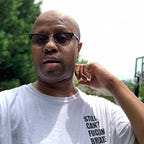Please Destroy These Shoes
Learning from Weartesters is a Must
Over a year ago I began working on a simple running shoe. The goal was to engineer a lightweight yet durable product that would be as comfortable on morning strolls as they would be in 5k road races.
Our first samples were well executed by an amazing factory partner and the feedback from retailers and consumers were all positive. Fresco BK at Stadium Goods and Sue Boyle at Rime NYC helped the team decide which colors were rocks stars and which colors were duds. Our podiatrist Dr. Roxann Clarke gave us two thumbs up as she compared our product to the best running shoes in the market.
But as a designer and engineer, that doesn’t make you feel better. It just makes you more anxious.
I learned this in my first few weeks of working in Nike Basketball nearly 20 years ago. Every shoe that ever landed on an NBA or NCAA court made Jeff Johnson and Craig Santos — development and innovation directors in NIKE Basketball— nervous. There are thousands of details and processes that make up a shoe — from how long you cook a midsole to the chemistry of glues that keep a heel counter in place. Every decision that lead up to those shoes being worn by the best players in the world was managed by these engineers. Their worst nightmare was having a shoe fall apart in the middle of a game.
No amount of testing in the lab will guarantee 100% success — especially if you’re pushing the envelope with design & engineering or exploring new partners in manufacturing & components. You have to put product through real world testing to get feedback from people who will push your product farther than most consumers would ever imagine.
For Nike Basketball it wasn’t enough to test size 9’s in the Bo Jackson Fitness Center. The team organized entire events around getting feedback from professionals in order to see how the product would hold up.
In Japan we worked with collegiate runners at 5:30AM as they prepared for their annual Ekiden relay race. Our team of engineers and weartest coordinators painstakingly detailed every like and dislike these elite athletes would share with us — even when they were too polite to tell us how they really felt. From lace length to material breathability, we wanted to know everything they could tell us about how our product worked. Hours upon hours of feedback pushed us to develop a shoe capable of winning Olympic Gold.
Even at Cole Haan we stressed weartesting beyond the standard dress shoe protocol. We were building concepts that challenged the brand and the consumer, so we brought PhD candidate from Columbia University Ajaya Williams to help us collect the feedback we needed to move forward or redesign our ideas.
Today I work with companies that can incorporate feedback from the testing of 36 people in 3 weeks and teams that are lucky to get 4 pairs of shoes to test over 12 weeks. Though the size of the businesses vary, the conversations are the same because every customer is an individual.
When I asked Alex Gardener, a serious runner in NYC, to test the simple shoe we started a year ago, I simply hoped he would take it for a spin around the block. Alex and his Peter are hardcore runners that run 10k’s for family fun. Instead of a simple test drive, Alex put the shoe through 10 miles. Then 20 miles. We talked about the overall comfort and support and traction. He was extremely enthusiastic about the product.
So I asked him to keep running in them.
I wanted them to fall apart.
Over the next 5 weeks Alex wore them in the rain and heat that was NYC Summer 2018. After 250 miles, the shoes held up well, but now he had real feedback. “I think overall the shoe held up very well. I would say it felt a little less substantial than my Brooks Ghost 11’s but I didn’t see any difference in performance. All of the support I needed was there,” Alex told us. We needed a stiffer counter so the shoe felt more substantial if we wanted distance runners to choose a minimal model over their core training shoe, but the minimal interior construction patterned after the Japanese racing product I had worked on 15 years prior still worked.
Fresco at Stadium Goods and Sue at Rime NYC gave us feedback on everything from colors & materials to price & distribution.
But with feedback from folks like Alex that are willing to destroy our product, we know we are headed in the right direction for our March 2019 launch on Nice Things NYC.
